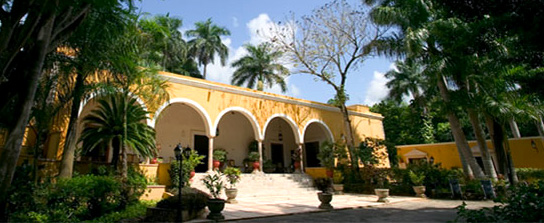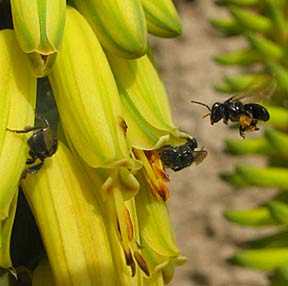|
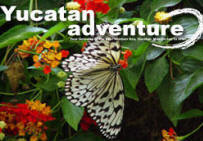




Yucatan Adventure
Eco Travel Guide:



▫
Dioon Cycads
▫
Papaya Tree
▫
Ceiba Tree
▫ Agaves and Cactus




Other Articles
of Interest:
▫
Maya People
▫ Maya Spa
▫
Mayan Cooking
▫
Mayan Rituals
▫
Mayan Fine Arts
▫
Mayan Calendar
▫
Maya Civilization
▫
Colonial
Tradition
▫
Mayan Gods
/
Deities
▫
Maya
Cosmo-Vision
▫
Weddings
Destination
▫
Safe Travel Tips
▫
Things To Do
▫
Contact Us
Visit our Sponsor's
sites:
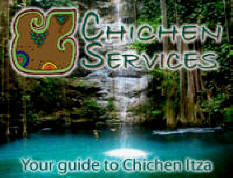
Eco-Cultural
Vacation
Packages to fully enjoy
Chichen Itza, Yucatan.
YUCATAN FLORA:
▫
Dioon Cycads
▫
Papaya Tree
▫
Ceiba Tree
▫
Agaves / Cactus
▫ Jim
Conrad's Nature Notes
|
Yucatan Adventure Geo-Travel
Guide
and Hacienda Chichen Resort
Gateway to the best Chichen Itza, Yucatan, Mexico, has to offer.
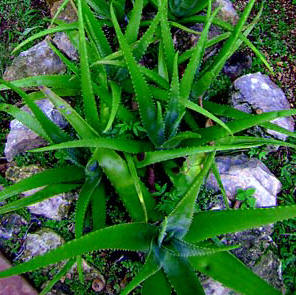
Agaves and Cactus
Information Guide:
Agave Sausalito
l
Mother-in-law
Tongue
l
Aloe
Yucca
Aloe vera
l
Agave
desmettiana
l
Lush
Tropical Gardens and Beautiful Flora -
Hacienda Chichen, Chichen Itza, Yucatan
Aloe Vera Agave
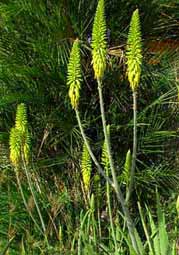 Aloe Vera
(English), Sabila (Spanish), Jun Peet's K'iin
Kij (Maya),
Aloe vera, family: Asphodelaceae. Native to
Africa it was brought to
Hacienda Chichen in the early 1960s. Mayan have
benefited from the plants
healing properties.
Aloe Vera plants grow in a rosette pattern, about to
60–100 cm; succulent leaves have inner clear juice
pulp or gel that is highly use in
herbal healing remedies for its skin care qualities
at
Yaxkin Spa, see our
Nature
Eco-Spa Wellness Vacation
offers. Pamper yourself with the healing
power of this plant
Yaxkin Spa Skin Care.
Aloe Vera gel is rich in amino acids, minerals, vitamins and
trace elements, Aloa Vera organic natural gel is a clear sticky
substance: tasteless, colorless and odorless. Aloe Vera
(English), Sabila (Spanish), Jun Peet's K'iin
Kij (Maya),
Aloe vera, family: Asphodelaceae. Native to
Africa it was brought to
Hacienda Chichen in the early 1960s. Mayan have
benefited from the plants
healing properties.
Aloe Vera plants grow in a rosette pattern, about to
60–100 cm; succulent leaves have inner clear juice
pulp or gel that is highly use in
herbal healing remedies for its skin care qualities
at
Yaxkin Spa, see our
Nature
Eco-Spa Wellness Vacation
offers. Pamper yourself with the healing
power of this plant
Yaxkin Spa Skin Care.
Aloe Vera gel is rich in amino acids, minerals, vitamins and
trace elements, Aloa Vera organic natural gel is a clear sticky
substance: tasteless, colorless and odorless.
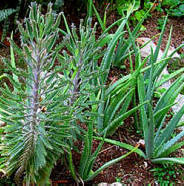 Aloe
Vera plant is a stem-less or short-stemmed succulent plant, growing
to 60-85 cm tall. It spreads, by way of offsets and root sprouts.
The leaves are lance shaped, thick and fleshy with a serrated edge.
Flowers are produced on spikes. The individual single flowers are
pendulous. Aloe Vera Juice and gel are produced from the leaves.
This wonder succulent herb is used for all kinds of medicinal
healing, from digestive problems to heal ulcers, burned skin
and stop bleeding from the intestines. It also aids in hair
lost prevention. Aloe
Vera plant is a stem-less or short-stemmed succulent plant, growing
to 60-85 cm tall. It spreads, by way of offsets and root sprouts.
The leaves are lance shaped, thick and fleshy with a serrated edge.
Flowers are produced on spikes. The individual single flowers are
pendulous. Aloe Vera Juice and gel are produced from the leaves.
This wonder succulent herb is used for all kinds of medicinal
healing, from digestive problems to heal ulcers, burned skin
and stop bleeding from the intestines. It also aids in hair
lost prevention.
Agave
Joe Hoak or "Sisalito" - Agave meridensis variegata
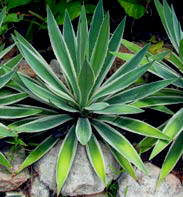 Agave
'Joe Hoak' (English), Chelem (Maya) Sisalito (Spanish) Agave meridensis variegata,
Agavaceae (Agaves) Family; Native to
Yucatan, Mexico. A truly striking variegated rosette
shaped succulent, grows 2 feet tall by 3 feet
wide; now cultivated worldwide as an
ornamental plant. Leafs beautifully variegated with
blue-green centers and cream sharp edges, ending in a
hard red spine. The mature succulent agave is quite
impressive. Plant enjoys frequent water, full sun,
tolerates semi-shaded area; roots propagates new
offspring. Agave
'Joe Hoak' (English), Chelem (Maya) Sisalito (Spanish) Agave meridensis variegata,
Agavaceae (Agaves) Family; Native to
Yucatan, Mexico. A truly striking variegated rosette
shaped succulent, grows 2 feet tall by 3 feet
wide; now cultivated worldwide as an
ornamental plant. Leafs beautifully variegated with
blue-green centers and cream sharp edges, ending in a
hard red spine. The mature succulent agave is quite
impressive. Plant enjoys frequent water, full sun,
tolerates semi-shaded area; roots propagates new
offspring.
Agave
Sisal or "Henequen"- Agave fourcroydes
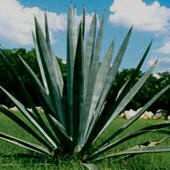 Sisal
Plant (English)
Henequen
(Spanish) Kih (Maya), Agave
fourcroydes Lem.
Agavaceae Family.
Henequen or sisal agave originated in
the Yucatan Peninsula differs from Sisal, Agave
sisalana,
slightly; both are highly fibrous agave hybrids that
propagates with basal growing suckers. Henequen
agaves have sword-shaped leafs rosette that grow 1.5 to
2 meters tall. Its fiber had a high commercial value before man-made
fibers replaced natural fibers in the manufacturing of
ropes. Sisal
Plant (English)
Henequen
(Spanish) Kih (Maya), Agave
fourcroydes Lem.
Agavaceae Family.
Henequen or sisal agave originated in
the Yucatan Peninsula differs from Sisal, Agave
sisalana,
slightly; both are highly fibrous agave hybrids that
propagates with basal growing suckers. Henequen
agaves have sword-shaped leafs rosette that grow 1.5 to
2 meters tall. Its fiber had a high commercial value before man-made
fibers replaced natural fibers in the manufacturing of
ropes.
From Jim
Conrad's writtings: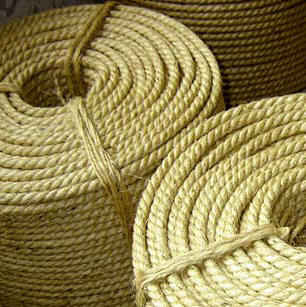
Henequen
[ pronounced: HEN ah kin] is the Spanish name for the plant:
Agave
fourcroydes. The Maya word for the plant is variously
written Kij, Kih, or
Kiiw.
The
Maya word for the fiber
is Sook’, So’ok’, or
Sod skil.
Sakal
[pronounced sah Kal] is the Maya name for the panels of henequen
cloth woven of fibers, not thread or twine on the back-strap loom.
The size of the panel is limited to the length of the fiber strands,
by the width that the weaver can reach, and by the weight that her
back can support. Paños
is the Spanish word.
Sisal
[pronounced: SIGH saul] is often used to mean Henequen fiber.
However, it is not uncommon that the name is used for any rough,
coarse twine and fabric. The Sisal fiber of Africa and Brazil are
selected varieties of the original Agave, smuggled out of the
Yucatan early on. The variations in characteristics are due to the
selection of clones and to different growing conditions.
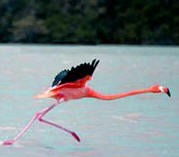 Sisal
[pronounced: see SAL[as in sally]] is also the name of an ancient
Mayan port in the north coast of Yucatan where salt trade used to
continue during the Colonial period in the Yucatan peninsula; through Sisal
Port the bales and crates of the henequen fiber, rope, and binder
twine were shipped to the rest of the world for decades during the
19th and 20th Century. The crates, bundles and bags were stamped in
large letters with the name of the port of origin, Sisal, and this
became the commonly used name for the fiber. Sisal was an ancient
Maya port. However, as railroads and factories sprung up in and
around Merida, the new port of Progreso was developed directly north
of the city. Sisal
[pronounced: see SAL[as in sally]] is also the name of an ancient
Mayan port in the north coast of Yucatan where salt trade used to
continue during the Colonial period in the Yucatan peninsula; through Sisal
Port the bales and crates of the henequen fiber, rope, and binder
twine were shipped to the rest of the world for decades during the
19th and 20th Century. The crates, bundles and bags were stamped in
large letters with the name of the port of origin, Sisal, and this
became the commonly used name for the fiber. Sisal was an ancient
Maya port. However, as railroads and factories sprung up in and
around Merida, the new port of Progreso was developed directly north
of the city.
Mother-in-law Tongue or "Lengua de Vaca"
Sansevieria trifascatiata
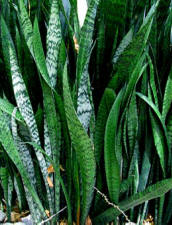 Mother-in-law
Tongue (English),
Lengua de Vaca (Spanish),
Sansevieria trifasciata, Ruscaceae family.
Mother-in-law tongue is a succulent plant that prefers full sun, but can tolerate low light conditions.
Native to Africa it is common in Yucatan, Mexico, where
it grows up to a meter and a half (5ft.)
Hacienda Chichen
Lush Tropical Gardens has evergreen, variegated, and
dwarf Mother-in-law Tongue varieties. These are
herbaceous perennial succulent that need little water
and are very drought tolerant; they propagate through
clumps spreads and leaf cuttings; each bloom spreads a
delightful night fragrance. Rural Mayan people nowadays use its fiber to
handcraft
art paper. Mother-in-law
Tongue (English),
Lengua de Vaca (Spanish),
Sansevieria trifasciata, Ruscaceae family.
Mother-in-law tongue is a succulent plant that prefers full sun, but can tolerate low light conditions.
Native to Africa it is common in Yucatan, Mexico, where
it grows up to a meter and a half (5ft.)
Hacienda Chichen
Lush Tropical Gardens has evergreen, variegated, and
dwarf Mother-in-law Tongue varieties. These are
herbaceous perennial succulent that need little water
and are very drought tolerant; they propagate through
clumps spreads and leaf cuttings; each bloom spreads a
delightful night fragrance. Rural Mayan people nowadays use its fiber to
handcraft
art paper.
Yucatan Yuca - Yucca yucatana
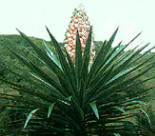 Yucatan
Yucca (English) Aloe Yuca (Spanish) Yucca yucatana or
Yucca aloifolia,
Agavaceae or more currently described as a
Asparagaceae
family. It is native succulent plant to Yucatan, Mexico.
Yucatan yucca is the emblem of the state of Yucatan in Mexico.
This yucca is of the genus of perennial shrubs and trees in the
agave family, . Its 40-50 species are notable for their rosettes of
evergreen, tough, sword-shaped leaves forming rosettes that have
large terminal panicles of white or whitish flowers. They propagate
with pollination growing seeds but also with offsets. Ornamental and
edible plants with evergreen leafs, it requires full sun and little
water, bloom late summer. Yucatan yucca is also known as a
Spanish Bayonet in some English speaking regions. The leafs of
aloe yucca are used for pain relief of arthritis by Mayan
healers who prepare them in a cleansing and smoothing paste rub. Yucatan
Yucca (English) Aloe Yuca (Spanish) Yucca yucatana or
Yucca aloifolia,
Agavaceae or more currently described as a
Asparagaceae
family. It is native succulent plant to Yucatan, Mexico.
Yucatan yucca is the emblem of the state of Yucatan in Mexico.
This yucca is of the genus of perennial shrubs and trees in the
agave family, . Its 40-50 species are notable for their rosettes of
evergreen, tough, sword-shaped leaves forming rosettes that have
large terminal panicles of white or whitish flowers. They propagate
with pollination growing seeds but also with offsets. Ornamental and
edible plants with evergreen leafs, it requires full sun and little
water, bloom late summer. Yucatan yucca is also known as a
Spanish Bayonet in some English speaking regions. The leafs of
aloe yucca are used for pain relief of arthritis by Mayan
healers who prepare them in a cleansing and smoothing paste rub.
Agave
Desmettiana
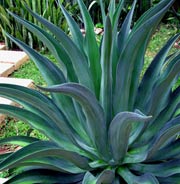 Agave Desmettiana (English), Maguey
Semati (Spanish) Ki (Maya), Agave desmettiana,
Agavaceae Family native to Mexico. This lovely agave has deep
blue green leafs with smooth edges and a red spine tip.
Agave desmettiana
grows a single spike with cymes of big yellow flowers,
that can reach up to 2.5 meters in height and last
up to three months. The plant dies after flowering, and
propagates producing suckers (basal
shoots). Agave desmettiana grows best in
Yucatan
planted in indirect
sun garden areas.
Agave Desmettiana (English), Maguey
Semati (Spanish) Ki (Maya), Agave desmettiana,
Agavaceae Family native to Mexico. This lovely agave has deep
blue green leafs with smooth edges and a red spine tip.
Agave desmettiana
grows a single spike with cymes of big yellow flowers,
that can reach up to 2.5 meters in height and last
up to three months. The plant dies after flowering, and
propagates producing suckers (basal
shoots). Agave desmettiana grows best in
Yucatan
planted in indirect
sun garden areas.
Agave Desmettiana Conservation status:
Distribution and habitat: Mexico - Oaxaca, Veracruz, Yucatan
Description of Agave Desmettiana:
Asparagaceae
Family
- flowering stem 2.5 m tall, 10 cm diam.
Leaves Blue-green tones with white powder,
smooth,
ending with sharp spines.
Flowers clusters appear at the end of the
agave life cycle atop a asparagus like steam. Lime
yellow color as shown bellow.
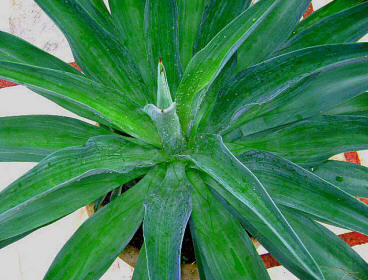
At Hacienda Chichen's lush tropical
gardens, guests can enjoy viewing many Agave Desmettiana clusters,
U.S. naturalists and gardeners usually referred to this
medicinal agave by its technical name in English, by anyone
speaking of it with enough savvy and interest to distinguish
it from the many other agave species. Some would call
it Century Plant or Maguey, but those names are better
reserved for another agave species, one with larger, thicker
leaves but a similarly giant inflorescence, Agave
americana.
We invite you to review
our
Complete Hacienda Chichen's Flora Guide filled
with beautiful photographs of fruit trees, Mayan medicinal plants,
fruit trees, and an exquisite Palm collection found in the lush tropical
gardens and private Maya Jungle Nature Reserve of this unique green
boutique hotel.
***
Agave and Cactus photos by Belisa B. Gordon - Jim Conrad
Jim Conrad's own writing:
Agave Desmettiana Flowering
at
Hacienda Chichen's Entrance
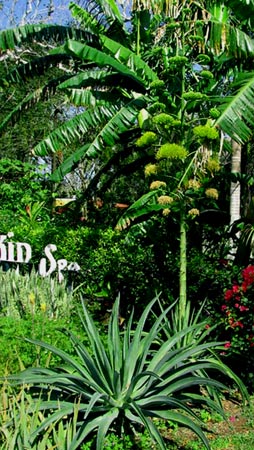 Agave
desmettiana is a large and beautiful ornamental agave found
in Yucatan. Usually referred to by its technical name in
English by savvy gardeners to distinguish it from the many other
agave species. Some people would call it Century Plant or Maguey,
but those names are better reserved for another agave species, one
with larger, thicker leaves but a similarly giant inflorescence,
Agave americana. Agave
desmettiana is a large and beautiful ornamental agave found
in Yucatan. Usually referred to by its technical name in
English by savvy gardeners to distinguish it from the many other
agave species. Some people would call it Century Plant or Maguey,
but those names are better reserved for another agave species, one
with larger, thicker leaves but a similarly giant inflorescence,
Agave americana.
At Hacienda
Chichen's pretty entrance an agave is very conspicuously flowering
right photo). Two agaves are shown but only
the one in the back is flowering (notice the large asparagus like
steam where clusters of bright lime yellow flowers abound, this
inflorescence stands about eight feet tall (2.5m). Some agave
species bloom from year to year, others at intervals, and others
only once. Agave desmettiana grows for years, then
flowers once and dies. All is not lost, however, because as
the plant matures it produces basal shoots that later will replace
the dead plant, plus these shoots easily root when transplanted
elsewhere.
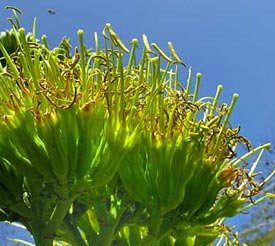 In
this next photo you can see how within the inflorescence individual
blossoms are clustered in well separated groupings (right photo).
Agave Desmettiana flower clusters have small single green flowers
that as they mature take a cream-yellowish tone (see left photo).
In the next photo (left) you can see one side of the flower has been
removed to reveal the oval ovary at the flower's bottom. The
ovary is topped by a thick, stiff, whitish style terminating in a
rounded stigma. In agave flowers six In
this next photo you can see how within the inflorescence individual
blossoms are clustered in well separated groupings (right photo).
Agave Desmettiana flower clusters have small single green flowers
that as they mature take a cream-yellowish tone (see left photo).
In the next photo (left) you can see one side of the flower has been
removed to reveal the oval ovary at the flower's bottom. The
ovary is topped by a thick, stiff, whitish style terminating in a
rounded stigma. In agave flowers six
stamens are attached to the walls of a funnel-shaped perianth.
Perianth is the word used when a blossom's calyx and corolla are
merged r indistinguishable from one another. In the picture the
slender, stiff, greenish, incurving things are the stamens'
stalk-like filaments, and each filament is terminated by a
yellowish, banana-like anther, which splits open at maturity to
release pollen.
Nowadays most references place agaves in their own family, the
Agavaceae, but some sink the agave family into the newly recognized
and expanded Asparagus Family, the Asparagaceae. If you think about
it, the above agave flower is indeed structured somewhat like an
asparagus flower, only much, much larger.
Agave desmettiana is a native Yucatec plant now grown
worldwide in frost-free areas, in pots and urban gardens, in full
sun. I find it growing here and there in wild areas but can never
decide whether they are natural populations or plantings abandoned
long ago. Besides its pretty shape and ease to grow, one
reason Agave desmettiana is so widely planted is that its blades are
spineless. However, its reddish brown blade tips are hard and sharp,
very capable of puncturing your skin.
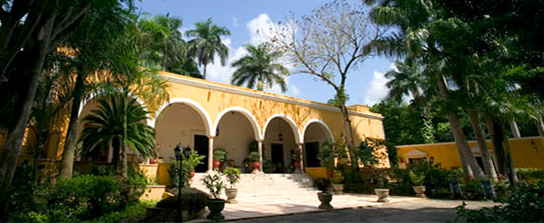
Yucatan flora: Cycads at Hacienda
Chichen Eco-Spa Resort, Chichen Itza, Yucatan, Mexico:
Agave
Tequilana
Blue Agave or Tequila Agave (English), Maguey (Spanish) Ki (Maya), Agave
tequilana,
Agavaceae Family native to Mexico. This important
comercial agave has deep
blue green leafs with smooth edges and a red spine tip.
Tequila blue agave grows mainly in the state of
Jalisco, Mexico where traditionally tequila spirits are
distilled since the Spanish Conquest, though a spirit
similar to tequila was produced by the Aztecs who called
it "octli."
Tequila is produced by
removing the heart (piña) of the plant in its twelfth year.
Harvested piñas normally weigh 80–200 pounds (40–90 kg).This heart
is stripped of its leaves and heated to remove the sap, which is
fermented and distilled. The best tequila spirits are made of 100%
blue agave, you may purchase it at
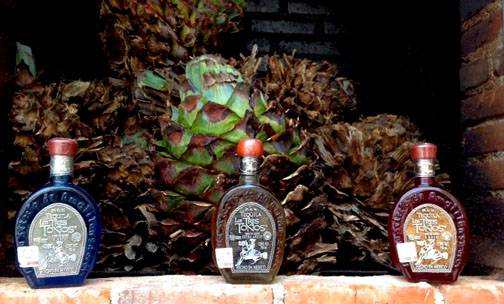
Hacienda Chichen Resort, in Chichen
Itza, Yucatan, Mexico,
offers visitors the opportunity to enjoy Mexico's famous
100% blue agave Tequila from a wide
variety of fine tequila selections. after
enjoying a tequila taste fair, we recommend you
visit our Toh
Boutique which is an active sponsor of the Maya
Foundation In Laakeech NGO. Your purchases support
our social work effort
Visit our recommended Chichen Services Mayan
Vacations Portal to enjoy Yucatan, Mexico:
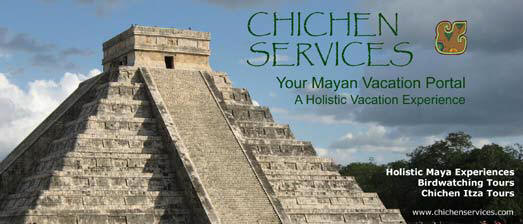
www.yucatanadventure.com.mx
Yucatan Adventure Green
Travel Guide is a volunteer Sustainable Green Travel Guide designed
by the Maya Foundation In Laakeech A. C. a NGO sustainable civil
society founded by Hacienda Chichen Resort's owners and staff in
Chichen Itza, Yucatan, Mexico. Hacienda Chichen's
sustainable green vision and eco-cultural mission committed to
provide travelers a soulful Mayan cultural experience as well as a
Green Getaway to explore the eco-wonders and cultural traditions of
the Maya; as well as to support the welfare of
Mayan rural communities and to promote
Sustainable
Geo-Tourism. Visit Hacienda Chichen Resort and
Yaxkin Spa's website:
www.haciendachichen.com
Enjoy
Hacienda
Chichen Resort's Flora Guide and Botanical Gardens beauty and
serenity when visiting Chichen Itza, Yucatan, Mexico.
Published Photos &
Information Courtesy of
Hacienda Chichen Resort and Mr. Jim Conrad
Maya Foundation In Laakeech A.C. Volunteer.
November 2009,
Sept. 2016
|
